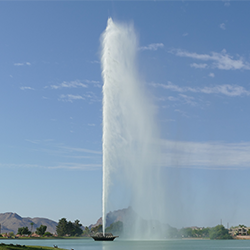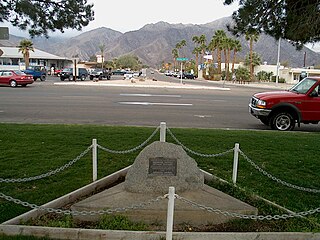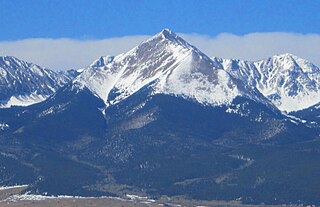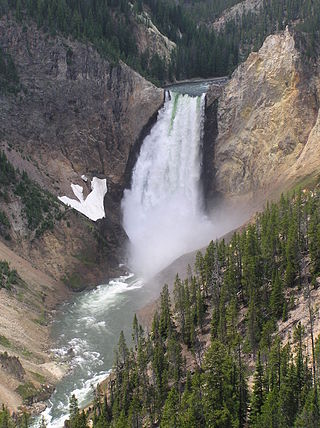
Light pollution is the presence of unwanted, inappropriate, or excessive artificial lighting. In a descriptive sense, the term light pollution refers to the effects of any poorly implemented lighting, during the day or night. Light pollution can be understood not only as a phenomenon resulting from a specific source or kind of pollution, but also as a contributor to the wider, collective impact of various sources of pollution.

Grand Canyon National Park, located in northwestern Arizona, is the 15th site in the United States to have been named as a national park. The park's central feature is the Grand Canyon, a gorge of the Colorado River, which is often considered one of the Wonders of the World. The park, which covers 1,217,262 acres of unincorporated area in Coconino and Mohave counties, received more than 4.7 million recreational visitors in 2022, which is the second highest count of all American national parks after Great Smoky Mountains National Park. The Grand Canyon was designated a World Heritage Site by UNESCO in 1979. The park celebrated its 100th anniversary on February 26, 2019.

Fountain Hills is a town in Maricopa County, Arizona, United States. Known for its impressive fountain, once the tallest in the world, it borders the Fort McDowell Yavapai Nation, Salt River Pima-Maricopa Indian Community, and Scottsdale. The population was 23,820 as of the 2020 census. Between the 1990 and 2000 censuses it was the eighth-fastest-growing place among cities and towns in Arizona. The median value of an owner-occupied housing during the period 2016-2020 was estimated at $402,100.

Borrego Springs is a census-designated place (CDP) in San Diego County, California. The population was 3,429 at the 2010 census, up from 2,535 at the 2000 census, made up of both seasonal and year-round residents. Borrego Springs is surrounded by Anza-Borrego State Park, California's largest state park.

Westcliffe is a statutory town that is the county seat of Custer County, Colorado, United States. At the 2020 U.S. Census, the population was 435.

A nature reserve is a protected area of importance for flora, fauna, or features of geological or other special interest, which is reserved and managed for purposes of conservation and to provide special opportunities for study or research. They may be designated by government institutions in some countries, or by private landowners, such as charities and research institutions. Nature reserves fall into different IUCN categories depending on the level of protection afforded by local laws. Normally it is more strictly protected than a nature park. Various jurisdictions may use other terminology, such as ecological protection area or private protected area in legislation and in official titles of the reserves.

In the United States, a national monument is a protected area that can be created from any land owned or controlled by the federal government by proclamation of the president of the United States or an act of Congress. National monuments protect a wide variety of natural and historic resources, including sites of geologic, marine, archaeological, and cultural importance. In contrast, national parks in the U.S. must be created by Congressional legislation. Some national monuments were first created by presidential action and later designated as national parks by congressional approval.

The Commission for Dark Skies (CfDS) is the United Kingdom's largest anti-light-pollution campaign group forming part of the international dark-sky movement.

The protected areas of the United States are managed by an array of different federal, state, tribal and local level authorities and receive widely varying levels of protection. Some areas are managed as wilderness, while others are operated with acceptable commercial exploitation. As of 2022, the 42,826 protected areas covered 1,235,486 km2 (477,024 sq mi), or 13 percent of the land area of the United States. This is also one-tenth of the protected land area of the world. The U.S. also had a total of 871 National Marine Protected Areas, covering an additional 1,240,000 sq mi (3,200,000 km2), or 26 percent of the total marine area of the United States.

El Morro National Monument is a U.S. national monument in Cibola County, New Mexico, United States. Located on an ancient east–west trail in the western part of the state, the monument preserves the remains of a large prehistoric pueblo atop a great sandstone promontory with a pool of water at its base, which subsequently became a landmark where over the centuries explorers and travelers have left personal inscriptions that survive today.
The dark-sky movement is a campaign to reduce light pollution. The advantages of reducing light pollution include an increased number of stars visible at night, reducing the effects of electric lighting on the environment, improving the well-being, health and safety of both people and wildlife, and cutting down on energy usage. Earth Hour and National Dark-Sky Week are two examples of such efforts.

Goldendale Observatory State Park is an educational facility on the northern side of Goldendale, Washington, notable for its unusually large public telescope. The state park occupies five acres (2.0 ha) atop a 2,100-foot (640 m) hill.
The Indian Astronomical Observatory (IAO) is a high-altitude astronomy station located in Hanle, India and operated by the Indian Institute of Astrophysics. Situated in the Western Himalayas at an elevation of 4,500 meters (14,764 ft), the IAO is one of the world's highest located sites for optical, infrared and gamma-ray telescopes. It is currently the tenth (see List of highest astronomical observatories) highest optical telescope in the world. It is India's first dark-sky preserve.
Swan Reach is a river port in South Australia 127 km north-east of Adelaide on the Murray River between Blanchetown and Mannum in South Australia. It is on the left bank of the river. The Swan Reach Ferry is a cable ferry crossing operated by the state government as part of the state's road network. Swan Reach, with all parts below Lock #1, is also one of the lowest parts of the river. In 2009–2010 the river was about 1.5 metres below its normal level. In late 2022 and early 2023 the town experienced a flood with river levels not seen since the devastating flood of 1956. Homes and businesses on Victoria street were inundated, along with most of the holiday homes at Marks Landing. Widespread damage was caused. At the 2016 census, Swan Reach had a population of 283.

A dark-sky preserve (DSP) is an area, usually surrounding a park or observatory, that restricts artificial light pollution. The purpose of the dark-sky movement is generally to promote astronomy. However, astronomy is not the only objective of conserving a dark sky. A dark night sky is associated with many facets of history, philosophy, religion, societal development, poetry, song, mathematics, and science. Different terms have been used to describe the areas as national organizations have worked independently to create their programs. The International Dark-Sky Association (IDA) uses International Dark Sky Reserve (IDSR) and International Dark Sky Park (IDSP). A third designation, International Dark Sky Sanctuary, was introduced in 2015.

The Kerry International Dark-Sky Reserve is a dark-sky preserve in County Kerry, Ireland. It was designated Ireland's first International Dark Sky Reserve by the International Dark-Sky Association (IDA). Kerry International Dark-Sky Reserve was awarded the Gold Tier Award on 27 January 2014, by the IDA. It was the first Gold Tier Reserve in the northern hemisphere, and is one of only four Gold Tier Dark-Sky Reserves in the world.

The Central Idaho Dark Sky Reserve is a 1,416-square-mile (3,670 km2) dark-sky preserve near the Sawtooth National Recreation Area, in the U.S. state of Idaho. It was designated on December 18, 2017 and is the first gold-tier dark sky preserve in the United States. The area was designated by International Dark-Sky Association. The area includes the city of Ketchum, Idaho which was separately designated a "Dark Sky Community" in 2017. Idaho State Highway 75 in the Sawtooth Valley between Redfish Lake and Pettit Lake roughly traverses the reserve's "core areas". Several sky quality meters are installed along State Highway 75 in this area.














